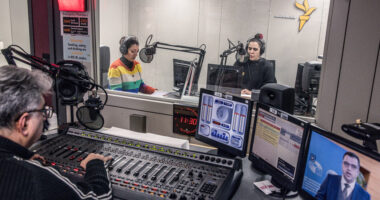
Times Insider explains who we are and what we do, and delivers behind-the-scenes insights into how our journalism comes together.
Last fall, after months of shadowing the reopening of a high school in Odessa, Texas, I realized I was being ghosted by a teenager. This hadn’t happened to me since I was a teenager myself, and it took me by surprise. Initially, Joanna Lopez, a senior at Odessa High School, had been excited to let us follow her through her pandemic-affected school year. But after a few months, we began to lose track of her. Text messages went unanswered. Phone calls went to voice mail.
As an audio producer for The New York Times, I had been working with colleagues on an audio documentary about Odessa High as a case study of how students, teachers and administrators were dealing with the coronavirus after a lockdown ended. That school, like others in Texas, opened its doors in August ahead of many districts across the country. Because coronavirus positivity rates were nearing 20 percent in Odessa, we decided to do all of our reporting remotely, asking students and teachers to document themselves with audio diaries and communicating with them via calls and texts.
Early in the process, we figured the story would be about a school district navigating the trade-offs between the health crisis and the education crisis. We braced ourselves to cover outbreaks in classrooms — to document teachers getting sick or students losing family members to the virus. Fortunately, none of our sources experienced that kind of loss firsthand. And as was the case in many schools across the country, the coronavirus outbreaks never occurred. Instead, a new crisis emerged: a crisis of mental health.
When Joanna finally answered one of our phone calls, she told us, “I keep meaning to get back to you, but I just keep falling asleep.” She wasn’t doing well. Early in the pandemic, her dad had lost his job in the oil fields of Odessa when the virus caused the economy there to collapse, and she had taken her first job at a smoothie shop to help pay her car loan. So like nearly half of the students in the school, Joanna had chosen to stay remote, in part so she could continue to work during school hours, even after the school reopened. Soon, her class work began piling up.
Now Joanna was skipping marching band practice, something she used to love. She had largely stopped working. She was failing three classes. And all she wanted to do was stay in her room.
April 30, 2021, 5:04 a.m. ET
Naomi Fuentes, a teacher at Odessa High, heard stories like Joanna’s nearly every day. “I’m going through a really bad depression phase right now,” one of them told her, via a Google form she would send around asking her students to report on how they were doing. Others wrote: “I’ve just been feeling so mentally and emotionally tired”; “I feel just overwhelmed and like I ruined my chances of graduating on time”; “Didn’t feel like getting out of bed today but still did.” She didn’t know what to do. Even the students she used to rely on, the ones who had always held themselves together, were struggling.
And instead of creating opportunities for support and solidarity, the pandemic managed to turn people against one another. After a member of the marching band tested positive, dozens of students in the band were required to go into quarantine, causing some to miss their last opportunity to play together as seniors. Parents were angry. The school nurses were exhausted. And the student in question was cyberbullied by former friends. She doesn’t talk to anyone in the band anymore. Like Joanna, she doesn’t see the point of those social interactions now.
It turns out that, in many ways, this pain was the story of Odessa’s reopening. Instead of telling the story of reconnection that comes with reopening, we produced a portrait of isolation and resilience as the school, and the community, struggled under the weight of the pandemic. The last episode of our four-part series, “Odessa,” which was also produced by Sindhu Gnanasambandan and Soraya Shockley and edited by Liz O. Baylen and Lisa Tobin, is available today.
As I worked on this series with our team from afar, I connected with these students’ experiences. I too have felt depressed this year. Getting out of bed is more difficult. I sometimes ignore friends who reach out to see how I am. I’ve felt like there’s nothing to look forward to. But, with the wisdom of adulthood, I know that this is temporary, that things are going to get better.
Class Disrupted
Updated April 22, 2021
The latest on how the pandemic is reshaping education.
After reporting this story, I wonder if these teenagers have that kind of insight and confidence in their futures. Their teacher, Ms. Fuentes, has been asking herself a question: Will they be able to see beyond this moment, to picture their futures? And I wonder, would I have been able to?
“Odessa” is a four-part audio documentary, made by Annie Brown, Sindhu Gnanasambandan and Soraya Shockley and edited by Liz O. Baylen and Lisa Tobin. All episodes are available now at nytimes.com/odessa.
Source: | This article originally belongs to Nytimes.com









